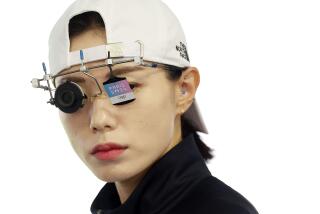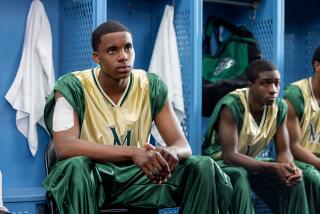Duo behind YouTube’s FreddieW channel pioneer Web filmmaking
On the campus of “Video Game High School,” gamers are the ultimate jocks. The best players appear on television chat shows. They even get dates.
The nine-part original Web series, which combines high school romances and dramas with video game-inspired race sequences and action scenes, attracted some 50 million online views in its first season. A second season is expected to debut in July.
It’s the brainchild of Freddie Wong and Brandon Laatsch — the collaborative duo behind the popular FreddieW channel on YouTube — and co-creator Matt Arnold. They represent a new generation of filmmaker, for whom the Internet is the primary destination, not a promotional platform to audition for a film or television job.
PHOTOS: Hollywood Backlot moments
“We always said that directors work their whole lives to get final cut on a movie,” said Wong, 27, using the industry term for creative control over the final edited version of a film. “We have that. So why would you want to run away from what every other director is sprinting toward their entire careers?”
The duo met in 2004 at USC, where Wong was a film major and Laatsch was studying sociology. They quickly discovered that they shared the same hobbies, including making short films while in high school and frequenting the same special-effects website.
“At the time we didn’t know how serendipitous it was because we figured there’s probably lots of guys like us that spend high school” making short films, said Laatsch, also 27. “We found out there weren’t very many.”
One Saturday, when everyone else on their dorm floor left for an excursion, Wong and Laatsch collaborated on their first short subject, “Aces,” a humorous fantasy about a poker game that turns to gunplay. They uploaded the 2006 video to an untested, incipient online video site called YouTube.
Wong and Laatsch kept an eye on YouTube while they did freelance visual-effects jobs and worked on direct-to-DVD films. In March 2010, they concluded that it was time to “drop everything” and focus on YouTube full time.
From a shared loft in downtown Los Angeles Wong and Laatsch spun popular videos like “Real Life Portal Gun,” based on the popular first-person shooter game “Portal,” and “Real Life Mario Kart,” a kart-racing video that simulates aspects of the classic Nintendo title.
ON LOCATION: Where the cameras roll
Wong emerged as the public face of the YouTube channel that bears his name. He can be seen satirizing Asian stereotypes in “Kung Fooled,” in which he fakes karate moves to foil an armed robbery. In “Far Cry Vacation,” he alleviates the boredom of a Belize vacation with a shootout on the sand and sea.
As their channel accrued more than 5 million subscribers, Wong and Laatsch began to attract the attention of Hollywood. “Iron Man” director Jon Favreau became aware of their work through his then 10-year-old son, who was a regular viewer of the FreddieW channel. He was impressed with the quality of the visual effects, which they managed to produce quickly and on a limited budget.
“Much like my beginnings in the independent film world, they were taking what was available to them and bringing an inspired vision to … millions of viewers,” Favreau said.
As part of the plan to promote his 2011 science-fiction action thriller “Cowboys & Aliens” to young, male video game fans, Favreau advocated for Wong and Laatsch to be part of the film’s digital campaign. The duo gained access to resources that they wouldn’t normally have, including the Universal Studios back lot and props from the movie.
Favreau even joined the FreddieW filmmakers during a one-day shoot on Denver Street, Universal’s “Western town.” Wearing a cowboy hat and animal hides, and announcing, “I roll with the Wong Gang now,” he joined Wong, Laatsch and others in an Old West shootout, complete with six-shooters, a tumbleweed and a few sci-fi twists.
“We went out there and shot this thing, put it online and all of a sudden a whole new audience was exposed to this concept and this movie,” Favreau said. “I know that anecdotally, looking at the comment section and the views it got, a tremendous amount of goodwill was curried … and it was a lot of fun.”
Videos like their Favreau mash-up laid the foundation for “Video Game High School,” a futuristic fantasy in which the best young gamers are recruited by elite boarding schools to sharpen their skills and go pro. The story follows Brian, a young player stuck in a town where he doesn’t belong, whose fortunes change when he scores a “kill” against the world’s top amateur player — a story that was informed by Wong’s own experience as a professional gamer.
The project, for which the Collective Digital Studio is co-producer and distribution partner, took six months to complete and employed a cast and crew of more than 160 people at a cost of $636,000. Wong, Laatsch and the Toronto-based visual-effects studio Playfight produced more than 600 visual-effects shots (about half as many as in the recent James Bond film “Skyfall”) for the movie-length project. Its pilot attracted more than 7 million views.
The second season was partially financed by a Kickstarter crowd-funding campaign that raised $800,000 in pledges from more than 10,600 backers. Shot in YouTube’s new Playa Vista digital production facility, it will launch with television-length episodes of about 22 minutes and a major brand sponsorship: Dodge provided three of its 2013 Dart compact cars and a Challenger muscle car for drift racing sequences.
During a break in production, Wong and Laatcsch look like the twentysomething hipsters that Dodge wants to reach. They wear jeans, T-shirts and hoodies, although Wong has wire-rimmed glasses. Laatsch is taller and has curly red hair.
“As marketers, we’re continually challenged as to how we can reach some of these 18- to 34-year-old millennials,” said Mark Malmstead, Dodge’s brand lead for social media.”We wanted to go where they are, where they live and play.”
“Video Game High School” presented an opportunity to showcase the car’s features. Dodge will use its social media to promote the new season of the show when it premieres and show behind-the-scenes footage from the making of the show on its own YouTube channel.
Wong and Laatsch said they agreed to the arrangement because it results in better content.
“Drift racing is expensive,” Wong said.
“No one calls ‘sellout’ when they get to see an awesome drift sequence,” Laatsch said.
MORE
INTERACTIVE: TVs highest paid stars
ON LOCATION: People and places behind what’s onscreen
PHOTOS: Hollywood back lot moments
More to Read
From the Oscars to the Emmys.
Get the Envelope newsletter for exclusive awards season coverage, behind-the-scenes stories from the Envelope podcast and columnist Glenn Whipp’s must-read analysis.
You may occasionally receive promotional content from the Los Angeles Times.









